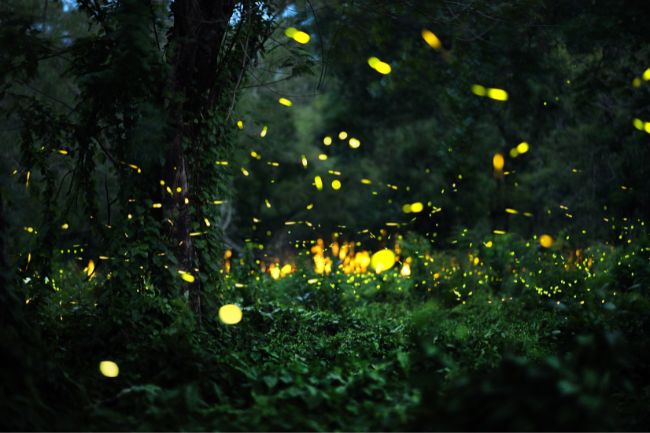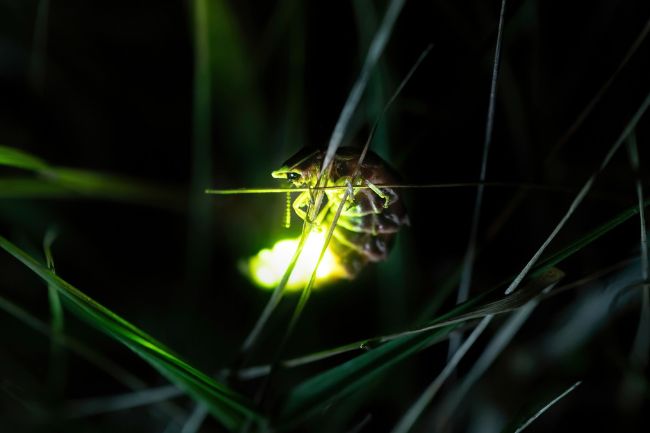Fireflies live across much of the world in tropical and temperate regions. Over 2,000 species are found across every continent apart from Antarctica. They can live in a variety of habitats, from woodland to grassland, usually in damp areas.
Contents
Where do fireflies live?

Fireflies are a type of beetle within the Lampyridae family, that use bioluminescence during their mating ritual and in order to warn potential predators that they are unpleasant to eat. There are over 2,000 species of firefly across the world, and they come in a range of colours and live in a wide variety of habitats.
| Habitat Type | Description |
|---|---|
| Moist Environments | Fireflies thrive in areas with high humidity and moisture, such as near rivers, ponds, and wetlands |
| Vegetated Areas | Fireflies prefer habitats with dense vegetation, including tall grasses, shrubs, and trees |
| Low Light Conditions | Fireflies are typically found in areas with reduced light pollution and dim ambient light |
| Protected Habitats | Fireflies are commonly found in habitats that are relatively undisturbed by human activities |
Though firefly species vary in many ways, most have some preferences in common.
Damp area
Fireflies generally like to live in damp areas. This may be within swamps or surrounding watercourses, or simply within coastal regions. While diets vary, many species feed on snails when they are in their larvae form, which may be another reason to live in damp areas.
Long grass
Most fireflies like to live in areas of long grassland. This may be because there is additional food for them within these habitats, or that the additional shelter hides them away from predators.
Temperate or tropical
Fireflies are mostly found in temperate or tropical regions and are unable to survive in areas where temperatures are much colder or in desert conditions.
Also read: Fireflies Food & Drink Explained (How, When…)
Where in the world are fireflies found?
| Geographic Region | Habitat Description |
|---|---|
| North America | Woodlands, meadows, and fields with dense vegetation |
| South America | Tropical rainforests and humid areas with abundant vegetation |
| Europe | Grasslands, wetlands, and forested areas |
| Asia | Rice fields, bamboo groves, and forests |
| Africa | Moist savannas, marshes, and forested regions |
| Australia | Wet coastal areas, rainforests, and temperate woodlands |
North America
There are roughly 200 species of firefly in North America, with tourists and locals alike often flocking to particularly well-known locations to watch and observe them during peak season. Photinus pyralis also known as the Big Dipper is one of the best-known species, which produces a synchronised display, which lights up every 4-6 seconds.
Photuris versicolor also known as The Triple-flash Photuris is a relatively large firefly at 10-15 mm (0.39-0.59in). Its name comes from the fact that it flashes two to three times in quick succession. It then repeats after a brief pause.
UK
The UK only has three species of fireflies, with two being very rarely recorded. Within the UK, fireflies are called glowworms. The most common species is Lampyris noctiluca, known as the common glowworm. It is mostly found in areas of unimproved grassland, with the flightless females climbing up the grasses and lifting their luminescent abdomens into the air to attract the males. The males are much less bright, but still have some bioluminescent.
Japan
There are around 45 species of firefly in Japan, known as Hotaru. The majority of these species do not glow, with only 14 species having the ability to create bioluminescence. Fireflies have long been significant in Japanese culture and folklore, and viewing fireflies is a significant tourist attraction in some areas.
India
There are eight species of firefly in India. In some areas, small festivals are held to celebrate the appearance of the fireflies. As in many countries, some species fly and gather in woodlands. Asymmetricata circumdata is one of the species that is found in woodlands, though it can also be found in other habitats.
Other areas
While fireflies may be more celebrated and visited in some countries than others, these amazing nighttime wonders can be found across much of the temperate and tropical world. Species, where the flying adult glows, are often best known, particularly if they gather in large numbers during their mating ritual.
However, there are many species of firefly which have lost their glow, and therefore are less visible and less enjoyed by humans.
What happens to fireflies during winter?
Like many insects, fireflies do not cope well with colder weather, and would quickly die if conditions became too harsh. Most species live for one or two years, with the adults usually dying shortly after mating.
For those species that live more than one year, they usually overwinter as larvae, the juveniles entering diapause, similar to hibernation, during the harsher conditions. Many will crawl into burrows, or hide under bark, to avoid the worst of the cold.
The fading light
Although still common in many areas, fireflies are struggling across the world due to a range of issues. In some countries, large declines are sadly being seen in many areas. These declines are down to a range of reasons.
Light pollution
Light pollution can severely affect firefly species, largely because the males can become attracted to and fly into lights, rather than finding the females and mating. LED lights that are replacing many conventional bulbs, as they use less electricity, seem to be more detrimental, as they are more attractive to fireflies.
Pesticides
Pesticides are widely used in farming across the world, however, most pesticides don’t discriminate between different kinds of insects. This means that when large areas are sprayed, insects such as fireflies get killed off along with more harmful species.
Habitat destruction
Another significant problem that affects many species is the destruction of the habitats they rely on. This destruction may come in the form of urban expansion, with areas being drained and built on, or with conversion to more intensive farming, which is less suitable for fireflies.
How to save the fireflies
As with many species, protecting them isn’t as complicated as it at first appears. One of the main things that could be done to protect firefly species, is to protect the areas where they are found. This means not developing sites and leaving enough wild areas for them to thrive. Or if development cannot be halted, then doing it in a way that means the fireflies still have the opportunity to thrive.
Examples of this more sensitive development could be to avoid outside lighting whenever not essential. Lighting can also be located lower to the ground, and angled in a way to send less light upwards and therefore attract males in.
Avoiding pesticides is also an important step, with many alternative farming techniques existing to deal with certain pest species. Even ensuring that pesticides are not used in areas where fireflies live can be useful.
While such changes in behaviour may sometimes be challenging, it certainly would be a shame to lose these magical creatures from our nights, along with all the joy they bring.


